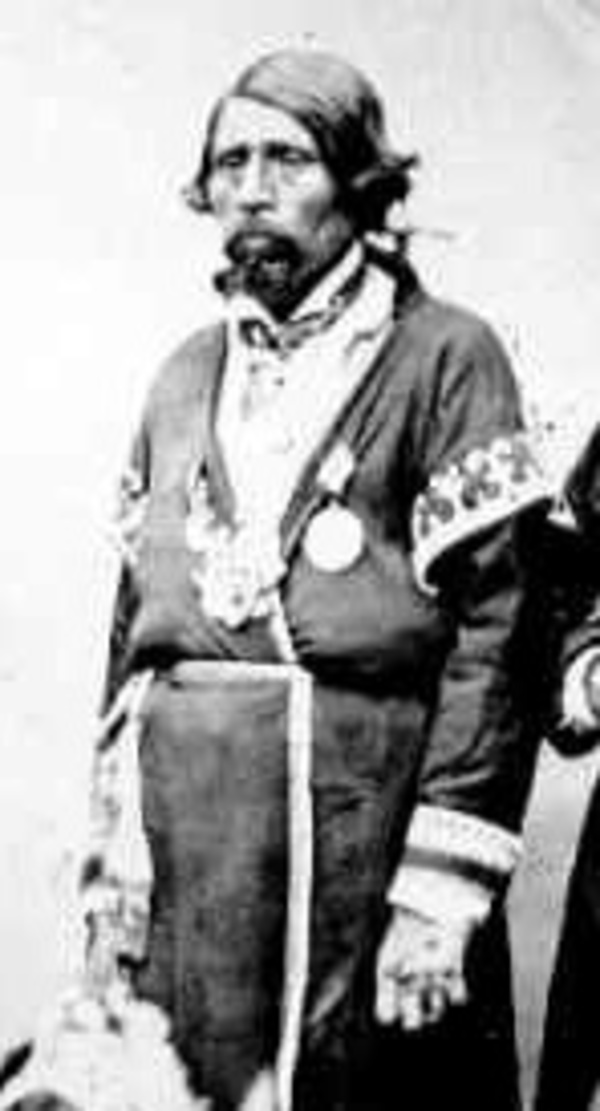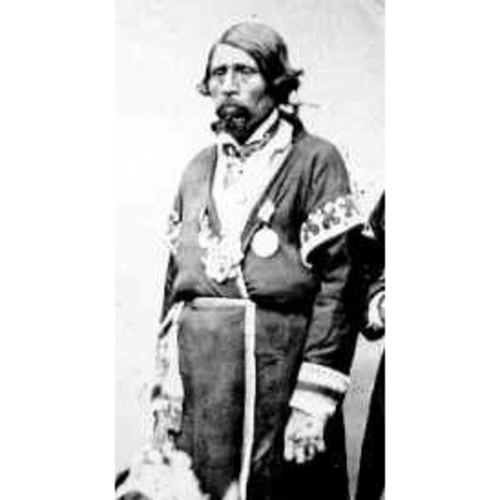
Source: Courtesy of Wikimedia Commons
PEMINUIT PAUL, JACQUES-PIERRE (James Peter; the forms Sa’kej Piel and Sah Biel reflect the Micmac pronunciation of his given names), Micmac grand chief and shaman; b. 5 Jan. 1800 at Rocky Lake (a short distance from present-day Bedford), N.S., son of Louis-Benjamin Peminuit* Paul and Madeleine —; m. first Sally —, and they had at least three sons and one daughter; m. secondly Mary —, widow of Louis Noel; d. 10 Jan. 1895 at the Shubenacadie Indian Reserve (No.14), N.S.
Jacques-Pierre Peminuit Paul was a member of the family of hereditary chiefs at Shubenacadie. His grandfather, Paul Peminuit, was probably the “Paul Pemminwick” who had been granted reserve land there in 1783. Paul Peminuit died in 1814 and the chieftainship passed first to his son Louis-Benjamin, and then, in 1843, to another son, François. Jacques-Pierre inherited the position in 1856 when François retired. He was confirmed as grand chief by Archbishop William Walsh* at St Mary’s Cathedral, Halifax, on 15 Sept. 1856, receiving a medal from Pope Pius IX and a written endorsement from the lieutenant governor, Sir John Gaspard Le Marchant*.
In 1847 Jacques-Pierre Peminuit Paul and his family had been reported very ill at “Maitland Chapel” (possibly South Maitland), suffering from “Indian Fever,” an undiagnosed epidemic that took the lives of many that year. A report the following year lists simply “James Paul, Shubenacadie, 2 in family.” It is known that his first wife and all his children predeceased him and that he remarried around this time; evidence would suggest these deaths occurred during the 1847 epidemic. Following his second marriage, Peminuit Paul adopted his wife’s son, John Noel, who was later to succeed him as chief.
As grand chief, Peminuit Paul was not politically remarkable; what makes him noteworthy is his reputation among his people as a kinap, a shaman with superhuman strength. It is still said that he could twist a clay pipe around his hat, then straighten it out for a smoke, or “squeeze a large bowl, china or clay, into a small one, then make it big again.” There are tales that he tore up a dam at Windsor to let the fish pass, ripped a living apple tree in half, and stopped a mill-wheel by taking hold of the shaft. When the miller expressed disbelief, Peminuit Paul said, “All I did was this,” and stopped the mill again. Max Basque stated in an interview that Peminuit Paul’s grandson Isaac Sack had affirmed, “No, I wasn’t the only one seen it, everybody seen it; just that he done so many weird things it didn’t surprise nobody. Didn’t surprise me any.”
Grand Chief Jacques-Pierre Peminuit Paul died of old age in 1895 and was buried on the Shubenacadie reserve. His reputation as a kinap however, is very much alive. Micmac elders, when shown his photograph in the 1970s, were uneasy and would not talk about this aspect of his life.
[Most of the information about Peminuit Paul’s reputation as a shaman is based on interviews conducted by the author with his great-great-grandsons, Max and Isaac Basque. (Tapes of Max Basque’s retelling of many of these stories are in Nova Scotia Museum (Halifax), Hist. sect., tapes, Basque 1984: 1–6.) The only published account is E. C. Parsons, “Micmac folklore,” Journal of American Folk-lore (New York), 38 (1925): 92–93. r.h.w.]
Peminuit Paul appears in two group photographs held in public collections. The earlier one, taken in Halifax around 1856, is in the Photo Coll. at the PANS; a later portrait, depicting several members of the Shubenacadie Indian Reserve (No.14, N.S.) during their St Anne’s Day celebrations (26 July), around 1890, is at the Nova Scotia Museum.
Newberry Library (Chicago), E. E. Ayer coll., [Pierre de] La Chasse, recensement des sauvages de l’Acadie, 1708. Nova Scotia Museum, Acc. 31.24; Accession books, I, no.3287;
Cite This Article
Ruth Holmes Whitehead, “PEMINUIT PAUL, JACQUES-PIERRE (James Peter) (Sa’kej Piel, Sah Biel),” in Dictionary of Canadian Biography, vol. 12, University of Toronto/Université Laval, 2003–, accessed January 9, 2026, https://www.biographi.ca/en/bio/peminuit_paul_jacques_pierre_12E.html.
The citation above shows the format for footnotes and endnotes according to the Chicago manual of style (16th edition). Information to be used in other citation formats:
| Permalink: | https://www.biographi.ca/en/bio/peminuit_paul_jacques_pierre_12E.html |
| Author of Article: | Ruth Holmes Whitehead |
| Title of Article: | PEMINUIT PAUL, JACQUES-PIERRE (James Peter) (Sa’kej Piel, Sah Biel) |
| Publication Name: | Dictionary of Canadian Biography, vol. 12 |
| Publisher: | University of Toronto/Université Laval |
| Year of publication: | 1990 |
| Year of revision: | 1990 |
| Access Date: | January 9, 2026 |



